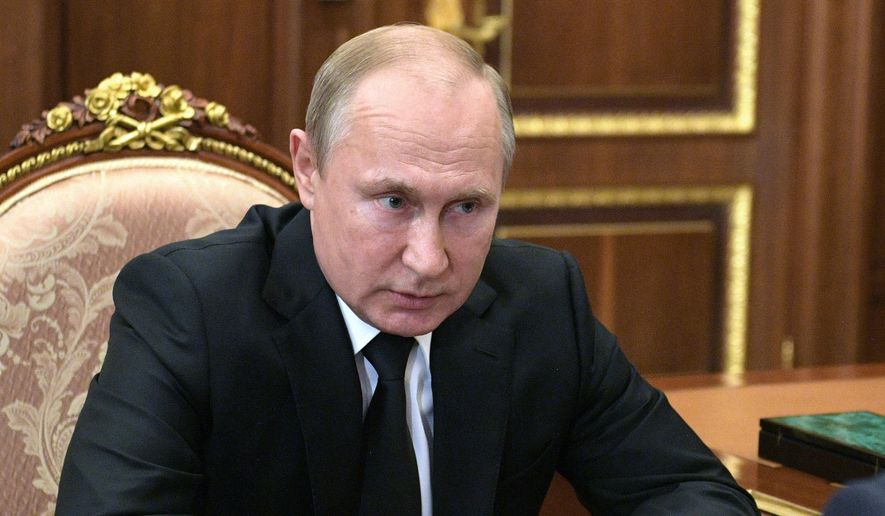Russian President Vladimir Putin signed a decree Wednesday to formally suspend Moscow’s participation in a 30-year-old strategic nuclear treaty, added a fresh layer to mounting international concerns over the prospect of a new Cold War-style arms race between the U.S. and Russia.
Mr. Putin’s move on the 1987 Intermediate-Range Nuclear Forces Treaty (INF) follows the Trump administration’s own steps toward withdrawing from the treaty in recent months. It also comes just weeks after U.S. intelligence accused Moscow of violating an entirely separate pact — the 1996 Comprehensive Test Ban Treaty.
Analysts have warned of a growing stand-off between the two nations. At the same time, there is expanding wariness in U.S. national security circles over the emergence of other powers — most notably China — as increasingly influential players on the global nuclear weapons landscape.
China and Russia see themselves in a new nuclear and missile competition with each other and the United States, Defense Intelligence Agency Director Lt. Gen. Robert P. Ashley Jr. told an audience in Washington recently.
The DIA director said Moscow, in particular, has been abandoning decades of nuclear-reduction efforts in favor a fresh stockpile that’s “likely to grow significantly.”
Speaking at the Hudson Institute think tank in Washington on May 29, Gen. Ashley also said U.S. intelligence officials believed Russia had “probably” violated the 1996 test ban treaty.
The DIA subsequently issued a clarifying statement asserting that “the U.S. government, including the intelligence community, has assessed that Russia has conducted nuclear weapons tests that have created nuclear yield.”
“These are actions that the U.S. government characterizes as inconsistent with the commitments undertaken by the United States, the United Kingdom, and France,” the DIA statement said, although it did not explicitly mention the Comprehensive Test Ban Treaty (CTBT).
The U.S. itself has never ratified the CTBT and critics of the pact, including National Security Adviser John R. Bolton, have long claimed it does not adequately define a nuclear test — allowing Moscow and Beijing to violate it.
With the test ban issue as a backdrop, the separate fight over the future of the INF Treaty has been brewing for months.
Negotiated by President Ronald Reagan and Soviet leader Mikhail Gorbachev and ratified by the U.S. Senate, the INF Treaty had prohibited the U.S. and Russia from building or deploying missiles and launch systems with a range from 300 to 3,400 miles.
For decades, the treaty prohibited the deploy of so-called tactical nuclear weapons in Europe.
But U.S. and NATO officials have argued Moscow’s new 9M729 missile system is a violation of the INF Treaty, despite Russian denials.
Citing the violation, along with concerns over the fact that China is not party to the INF Treaty, the Trump administration began formally moving toward withdrawal early this year, asserting that a full U.S. pull-out could only be avoided if Moscow first came back into compliance.
The back-and-forth sent fears soaring in some European capitals that the situation could devolve into a standoff, with the two sides moving to deploy tactical, intermediate-range nuclear missiles on the continent.
A report by the Russian-government-funded media outlet RT on Wednesday noted that the U.S. gave notice of its intention to withdraw from the INF Treaty in February and that Moscow had “followed Washington’s example” at the time. The report maintained that President Trump had “floated the idea of signing a ’new nuclear agreement’ with Russia after an hour-long phone call with Putin in May.”
At the time, Trump administration officials suggested a new INF pact might include buy-in from China. However, Chinese officials have indicated that Beijing has no interest in negotiating such a pact at this time.
The RT report, meanwhile, said that “Mr. Putin has warned the U.S. against deploying new missiles in Europe, saying that Russia will retaliate by fielding new fast weapons that will take just as little time to reach their targets.”
• Guy Taylor can be reached at gtaylor@washingtontimes.com.




Please read our comment policy before commenting.